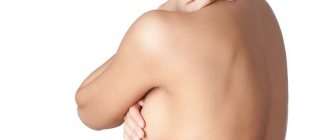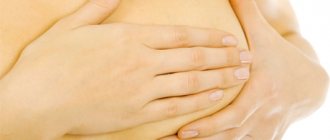Pain and palpable lumps in the chest can be a manifestation of various diseases. In most cases they are benign in nature. Malignant diseases develop much less frequently. In order to determine the exact cause of these symptoms, you need to consult a doctor.
- Why does a lump appear in the breast?
- Lumps and tenderness in the mammary gland during pregnancy and breastfeeding
- Self-examination of the mammary glands
- Diagnostics
- Treatment
- Prevention
Why does a lump appear in the breast?
Lumpiness in the chest along with painful sensations occurs with various diseases. These include:
- Benign breast tumor. Depending on the origin, adenoma, lipoma, fibroma and other neoplasms are distinguished. The tumor is a volumetric compaction. There may be one or more such formations in the breast tissue. The lump may be painful or may be painless. In some cases, breast discomfort occurs before or during menstruation.
- Breast cyst. This is a spherical or oval seal, represented by a cavity filled with liquid contents. This condition is most characterized by pain and discharge from the nipple.
- Nodular or diffuse mastopathy. It is characterized by the appearance of single or multiple compactions in the breast tissue as a result of hormonal imbalance. Symptoms of this condition are areas of palpable lumps and cysts in the tissues, pain and swelling of the mammary gland before menstruation, and discharge from the nipple.
- Malignant breast tumors. They are characterized by the appearance of a lump, a change in the shape of the mammary gland, deformation of the nipple and pathological discharge from it, as well as a change in the skin texture in the projection of the neoplasm. As the disease progresses and metastases appear, the size of nearby lymph nodes increases, their compaction and pain on palpation are noted. In the initial stages, the symptoms of breast cancer may not be pronounced enough.
Lumps and tenderness in the mammary gland during pregnancy and breastfeeding
During pregnancy and breastfeeding, the ratio of hormone levels in a woman’s body changes. During pregnancy, the corpus luteum and placenta synthesize progesterone, under the influence of which acini and ducts actively develop in the breast tissue - structures necessary for the production and secretion of milk. In the postpartum period, the mammary gland is already capable of lactation. If this process is disrupted, various diseases can develop, including:
- Lactostasis is the stagnation of breast milk in the breast tissue. As a rule, it develops in the early postpartum period. It is characterized by engorgement of the mammary gland, the appearance of compaction in the tissues, a feeling of fullness, and pain on palpation.
- Mastitis. This is an inflammatory disease of the breast of an infectious nature. Most often occurs during lactation. 95% of all cases occur in the postpartum period, 5% develop in pregnant women. Provoking factors are poor breast hygiene, lactostasis, decreased resistance to infection and cracked nipples. The clinical picture of mastitis occurs in stages. At the beginning of the disease, the mammary gland is enlarged in size, swollen, redness and sharp pain on palpation are observed. Additionally, fever and symptoms of intoxication are noted. Further, the inflammation is localized and manifests itself in the form of single or multiple compactions. Without timely treatment, mastitis can result in serious complications - an abscess or phlegmon of the chest.
It is impossible to determine the cause of tightness and pain in the chest area without a visit to a specialist and additional examination. However, certain diagnostics can be carried out independently. If a woman discovers signs of a particular disease, she should consult a doctor as soon as possible.
Symptoms of the disease
Signs of lactostasis can be divided into two groups: at an early stage and after inflammation has begun (in advanced form). Immediately after the blockage of the duct appears, the woman feels:
- chest pain;
- compaction in the area of one or more lobes;
- slight tissue swelling.
Departure is paid separately - from 550 rubles
Request a call
Call:
+7 (499) 455-08-05
Sometimes it happens like this: there is pain and swelling of the tissue, but there is no compaction. This happens with a slight lactostasis, which went away on its own. For example, milk stagnation occurred at night, and in the morning you fed the baby, and it resolved.
How to understand that inflammation has begun
More advanced lactostasis, which can only be treated with the help of a specialist, is often accompanied by a pronounced inflammatory process. Its symptoms:
- skin redness;
- increased body temperature;
- severe pain;
- bad feeling;
- heaviness in the chest;
- feeling of fullness of the gland.
If you have lactostasis, then the temperature will remain at 37-37.5 degrees. If it becomes higher, then this is a sign of the development of infectious mastitis. After the lobes and ducts are emptied, the temperature will drop within a few hours.
Self-examination of the mammary glands
The main rule for self-examination and palpation of the breast is regularity. Experts recommend performing a self-examination at least once a month and on the same day of the menstrual cycle. The first step is to examine your breasts. The woman carefully examines the skin for redness, bluish discoloration, rashes, or changes resembling “lemon peel.” You should also check the symmetry of the mammary glands. Slight differences in shape or size are not a symptom of any disease and are considered normal. If the asymmetry appears suddenly, is pronounced or continues to increase, the woman should inform the doctor about it. During further breast examination, the woman stands in front of a mirror and raises her arms up. The presence of retractions may indicate the presence of a malignant tumor.
The next step is to palpate the breast. The hand on the side of the breast being examined is raised behind the head. The fingers are placed flat on the chest. The examination is carried out around the chest - from the nipple to the periphery or vice versa. All areas of the breast should be examined.
You should also pay attention to nipple discharge. They may appear as spots on clothing that touches the breast or appear when pressure is applied to the nipple.
Go. Point by point details:
1. Read carefully: this is temporary . After 1-2 days, the breasts will enter the “working” mode, deal with the new working conditions, and the feeling of heaviness and fullness will go away. You not have such breasts throughout the feeding period. It is important for you and your baby to work well during these one and a half to two days, helping your breasts - and everything will work out.
2. What to do now ? The most important rule: do not let your breasts “rest.” She must work, give milk. Then the sensations will return to normal sooner.
An example of the wrong tactics is when your breasts begin to fill up, take a break from feeding until the morning - and what if it resolves somehow on its own. Right now.
An example of a correct one is to start feeding the baby more often, waking him up if he sleeps for too long. Pay attention to correct application (articles about how to assess whether it is correct and how to apply)
3. About waking up . Milk begins to come in, new sensations appear - we switch to the “ feeding on mother’s demand ” mode. You have every right to wake up your baby and ask him to help you if your breasts are already “calling.” This is also temporary.
4. Keep the path for milk clear .
a. There are different options for the arrival of milk: if everything is in order, the breast may become hot, heavy, even with some kind of compaction, but at the same time the areola remains elastic, the baby can latch on well (captures both the nipple and the areola), the milk flows freely. After feeding, such breasts become noticeably softer and lighter. In this case, you don’t need to do anything special, just apply-apply-apply (see point 2). Everything will return to normal very soon (see point 1)
b. But in some cases, and all sorts of stories are told about them, it turns out that swelling of the breast and areola is added to the fullness of the breast.
- The breasts feel “stony”, very painful, the areola is inelastic and overcrowded.
- Pressing on the areola is also painful (sometimes very painful! and this pain even interferes with feeding the baby).
- The nipple becomes flattened.
- The milk does not flow out - swelling interferes, blocking its path.
- It may be difficult for a child to latch onto such a breast; he slips from the dense areola (like a ball) onto the nipple or cannot latch on at all.
- Feeding often does not provide relief due to the fact that milk does not come out.
- Expressing milk isn't very good either.
This situation is called engorgement. Here the breasts and baby need additional help, which we will talk about. The main thing is to remember that this is not the end of the world and everything will work out.
Inside, breasts with and without engorgement differ in the level of swelling (diagram, just for clarity):
Diagnostics
If a woman has characteristic complaints, a number of diagnostic studies are performed:
- X-ray of the chest. Mammography is a screening diagnostic method that allows you to confirm the presence of a pathological focus in the mammary gland. Ductography is an X-ray contrast study that allows you to visualize the duct system of the breast.
- Ultrasound examination of the mammary glands. Helps determine the location, shape and extent of pathological compaction in the breast tissue. The method is safe and can be performed on pregnant or breastfeeding women.
- Breast biopsy. Histological examination of the breast lump helps to reliably determine the nature of the disease and distinguish a benign tumor from a malignant one.
- Thermography of the chest area - registration of thermal radiation from tissues. The method is based on the fact that actively dividing malignant cells emit more energy and appear redder in the image than surrounding healthy tissue.
To diagnose lumps and pain in the breast, it is mandatory to consult an oncologist-mammologist. An endocrinologist, gynecologist and other specialists may be involved.
Inverted, elongated or flat nipple
An unusual breast shape can only become a problem for your baby to latch onto the nipple if you apply it incorrectly. When applied correctly, the baby has not only a nipple in his mouth, but also an areola surrounding it, so the shape of the breast does not matter at all.
As a last resort, you can buy a silicone feeding pad at the pharmacy. It accurately repeats the shape of the ideal nipple for a baby, and babies happily suckle at the breast through it. In addition, using a breast shield will save your breasts from cracks and abrasions, and when your baby has teeth, from bites. But if you decide to purchase a breast shield, be prepared for the fact that your baby may get so used to it that he will refuse to latch on to the breast without it. Therefore, you will have to always carry the pad with you.
All problems that may arise during breastfeeding are completely solvable, so they are not a reason to transfer the baby to artificial feeding. Cracks and seals will pass without a trace, and nothing can replace the unique moments of closeness between mother and child during feeding.
Treatment
Treatment tactics depend on the cause of the lump and pain in the chest.
With lactostasis, the main task is to empty the mammary gland. To do this, a breast massage is performed; the woman is advised to avoid hypothermia and to put the baby to the breast in a timely manner. Adequate rest and good nutrition will not be superfluous. Night sleep is recommended in the side position. In some cases, oxytocin is prescribed, which stimulates the process of lactation and emptying of the mammary gland.
Antibiotic therapy plays a major role in the treatment of mastitis. The seal usually resolves with rational treatment. The development of purulent mastitis is an indication for surgical intervention.
Multiple or nodular mastopathy is subject to conservative therapy. Drugs are used that normalize hormonal levels. These include combined oral contraceptives, estrogen receptor inhibitors and other drugs.
A benign seal is usually treated surgically, since conservative methods are ineffective. Enucleation or sectoral resection of the mammary gland is used. In the first case, surgeons remove the tumor. There are usually no cosmetic breast defects left with this procedure. Sectoral resection is the excision of a tumor within healthy tissue. After this intervention, a slight deformation of the breast remains, which can be corrected with plastic surgery.
A compaction of a malignant nature is subject to surgical treatment. Mastectomy with removal of regional lymph nodes is recommended. In some cases, excision of the breast tumor within healthy tissue may be performed. The scope of the operation is determined by the oncologist, taking into account the extent of the tumor process. Alternative treatment methods include chemotherapy, radiation therapy, and targeted therapy. They are prescribed in various combinations with each other.
Mastitis
Mastitis is the most serious breast problem that can occur after childbirth and involves inflammation of the breast tissue. The cause of this misfortune is an infection that penetrated inside through cracks in the nipples. It can be either a separate disease or a complication of lactostasis.
If mastitis is suspected, an urgent visit to a gynecologist is necessary. Mastitis does not go away on its own. Antibiotic therapy will be required to treat it. In order to continue breastfeeding, the doctor will select medications that are compatible with it. If mastitis is not treated in a timely manner, a purulent abscess may develop, which can only be cured surgically in a hospital setting.
Prevention
To prevent breast diseases accompanied by thickening and pain, women should adhere to a healthy lifestyle: eat rationally, maintain a work and rest schedule, exercise regularly, avoid stressful situations, stop smoking and abusing alcoholic beverages. If you are overweight, you need to lose weight. You should also choose a comfortable bra that does not squeeze or injure your breasts.
Book a consultation 24 hours a day
+7+7+78
Cracked nipples
Cracks in the nipples most often appear due to improper attachment of the baby to the breast or improper weaning. When a baby suckles at the breast, a vacuum appears, and if the nipple is simply pulled out of his mouth, the vacuum will be broken and the nipple will be injured. Therefore, when the baby has fallen asleep on the breast, insert your little finger into the corner of his mouth and only then remove the breast.
Cracks in the nipples can also appear when using a breast pump or when using soap for bathing. A breast pump should only be used in extreme cases, and the breasts should simply be rinsed with water without using detergents.
As for how to treat nipples if cracks have already appeared on them, then under no circumstances should you use brilliant green, although a couple of decades ago gynecologists recommended it to all new mothers. Currently, there are more modern products that heal cracked nipples more effectively, do not dry them out and do not have such a bright color. Baby diaper creams containing panthenol, such as Bepanthen or D-panthenol, are excellent for treating nipples. They will heal the cracks in a couple of days and do not need to be washed off before feeding.










